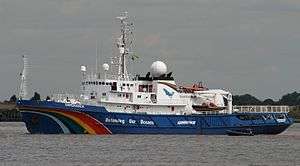MV Esperanza
 Esperanza on the River Thames off Gravesend, England, August 2010. | |
| History | |
|---|---|
| Name: | Vikhr-4[1] |
| Operator: | Northern Fleet |
| Builder: | Stocznia Północna, Gdansk, Poland |
| Yard number: | B98/04[2] |
| Launched: | 1984 |
| Renamed: | 1998 |
| Name: | MV Esperanza |
| Owner: | Stichting Phoenix Maastricht |
| Operator: | Greenpeace |
| Port of registry: | Amsterdam, Netherlands |
| Acquired: | 2000 |
| Recommissioned: | 2002 |
| Homeport: | Amsterdam |
| Identification: | Call sign: PD 6464 |
| Status: | in active service |
| Notes: | Former name: Echo Fighter |
| General characteristics | |
| Class and type: | Built as typ B98 |
| Type: | Expedition/research ship |
| Tonnage: | 2,076 GT |
| Length: | 72.3 m (237 ft 2 in) o/a |
| Beam: | 14.3 m (46 ft 11 in) |
| Draft: | 4.7 m (15 ft 5 in) |
| Ice class: | 1A |
| Propulsion: | 2 × 2,938 bhp (2,191 kW) Sulzer V12 engines |
| Speed: | 18.8 kts |
| Range: | 19,000 nautical miles |
| Boats & landing craft carried: | 2 large and 3 small rigid hull inflatables (RHIB) |
| Crew: | 33 |
| Aviation facilities: | Helipad |
MV Esperanza is a ship operated by Greenpeace. Previous to being a Greenpeace ship it was a fire-fighter owned by the Soviet Navy, built in 1984. It was recommissioned in 2000 and launched in 2002 after being named Esperanza ('hope' in Spanish) by visitors to the Greenpeace website. It had undergone a major refit by Greenpeace to make it more environmentally friendly. A new helicopter deck and boat cranes were also added.
The ship has a heavy ice class,[3] giving it the ability to work in polar regions. It has a top speed of 16 knots and an overall length of 72.3 m. This makes it the fastest and largest of the Greenpeace fleet.[3]
It has been involved in many campaigns, starting with the logging 'save or delete' campaign and currently in Cape Town.
Video equipment aboard
Greenpeace added live webcams to the Esperanza in 2006. The webcams are positioned on the bow of the ship, the mast and the bridge, they send a new image every minute to their Defending Our Oceans website and provide an archive of action.
In April 2006, the Esperanza was equipped with state-of-the-art underwater monitoring equipment, including a remotely operated vehicle (ROV) which can shoot video down to a depth of 300 m, and a drop camera capable of reaching depths of 1,000 m.
See also
- Rainbow Warrior (2011)
- MV Arctic Sunrise
- MY Steve Irwin (Flagship of the Sea Shepherd Conservation Society)
References
- ↑ Shipspotting.com. "VIKHR-4 - IMO 8404599 - Callsign PD6464 - ShipSpotting.com - Ship Photos and Ship Tracker". www.shipspotting.com.
- ↑ "Esperanza Arrives in Singapore for Maintenance Period".
- 1 2 "The Esperanza". Greenpeace International.
External links
| Wikimedia Commons has media related to Esperanza (ship, 1984). |
- Greenpeace's Esperanza page
- live webcam aboard Greenpeace's boats, including the Esperanza
- narrated virtual tour of the ship